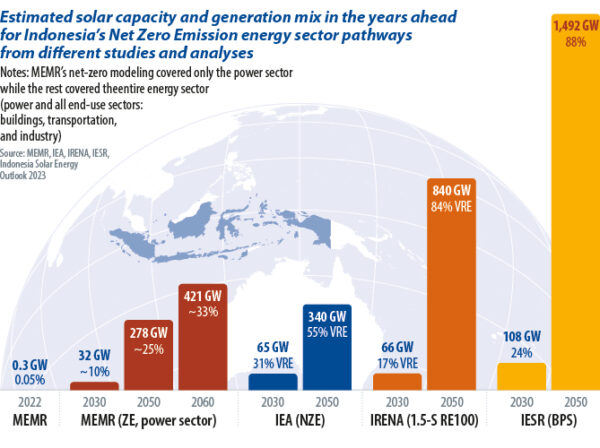Coal-dependent Indonesia has huge solar potential, but progress towards a net-zero economy has been slow, explain Indonesian think tanks Daniel Kurniawan and Fabi Tumiva .
23.05 p. of the magazine
Finally, in 2021, the Indonesian government announced a goal of zero emissions by 2060. Energy and Mineral Resources (MEMR), IESR, International Energy Agency (IEA) and International Renewable Energy Agency (IRENA) have recognized the important role of solar energy. According to IESR's 2023 Indonesia Solar Energy Outlook report, PV deployment is below CO2 requirements.
With a population of 275 million, Southeast Asia is the world's fourth largest economy and is projected to become the world's seventh largest by 2030. As the 15th largest country in the world, it contributes between 3 terawatt-peak (TWp) and 20 terawatt-peak to the technical capacity to generate solar power, depending on land use. According to an IESR study titled "Decarbonization of Indonesia's Energy System", about 1.5 TWp of this potential, covering 2.5% of Indonesia's territory, would support a zero emission energy system by 2050.

Cost-competitiveness, modularity and availability ensure that solar power will be the primary energy source in most of Indonesia's clean-balance economic models. According to the IEA model, solar energy and, to a lesser extent, wind energy will provide 55% of Indonesia's electricity by mid-century and will limit the increase in global temperature to 1.5°C this century. IRENA will provide 800-840 GW of solar energy by 2050, 54-62% of Indonesia's electricity. Both scenarios require greater grid flexibility, expansion of transport infrastructure, islanding and energy storage.
Current development
However, data from the Ministry of Energy showed that Indonesia was using only 270 MW of solar power at the end of December, which is about 0.01% of the minimum technical potential. Political and regulatory uncertainty and a lack of planning and implementation in the electricity market are affecting state-owned utility Perusahaan Electric Negara (PLN), which generates, transmits and distributes electricity.
For example, PLN's 10-year energy development plan envisages 4.7 GW of solar power by 2030, of which 3.9 GW by 2025. Last year there were only eight projects with a total generating capacity of 600 MW. Everything was applied before the lighting plan was created.
PLN has tendered the first phase of a plan announced last year to replace small 500 MW diesel power plants in remote areas, but a failed bid forced the project through a new round of procurement. The public service has been criticized for the uncertainty of the market, because there is no clear offer plan.
bright spots
They have been successful. Solar Power Purchase Agreement (PPA) prices fell 76% from 2015 to 2020, from $0.25/kWh to $0.058/kWh. It is a whopping 84% (less than $0.04/kWh) of the two bids by subsidiary PLN Indonesia Power, which share generation capacity for the floating solar projects in Singarak and Saguling. With an output of 110 megawatts. This year, PLN companies announced the second round of partner selection for the 100 MW floating solar power project at the Karangkates Dam, as well as utility-scale solar and wind farms.
They have moved on from the 2018 maximum metering rules, but PLN has lamented the introduction of restrictions. In 2021, Energy Minister Arifin Tasrif drafted an ordinance that states that every kilowatt-hour solar panel owners plug into the grid will generate a 65% credit on zloty-denominated electricity bills.
The energy minister also facilitated the process of implementing net metering, but PLN decided not to install the new system, citing concerns about network capacity. This limited the net output of solar systems to 10-15% of consumers' electricity connections.
In 2018, while industrial solar may benefit from rising electricity caps, residential and small business solar deployments are expected to face long payback periods with on-grid metering systems.
issue of PV magazine
The current issue of PV Magazine looks at China's journey to install 100GW of AC panels this year, a 20-year journey that Vincent Shaw and Frank Howitz see as a journey. We look at what Indonesia needs to achieve its zero energy goal and see signs of a solar revival in Europe with busy fairs and Gigafactor plans.
The Indonesian government and PLN still have work to do to make solar CO2 a success. The breakthrough came after last year's G20 presidents and Indonesia signed the Fair Energy Transition Partnership with several multilateral loans to finance the transition from coal to clean energy.
The early phase-out of coal and the widespread adoption of solar energy are key to meeting the country's goal of limiting 290 megatons of CO 2 emissions by 2030 and 34% of its electricity supply from renewable sources in that decade.
This year, as the energy chair of the Association of Southeast Asian Nations, Indonesia can strengthen the role of solar energy in the regional energy security situation by working together within and outside the energy system, including the advancement of the regional PV supply chain. . The path to clean, affordable and fair solar energy is clear, even if the road is rocky.
 About the Authors: Daniel Kurniawan is a Solar Energy Analyst at IESR and has participated in solar energy consultations with government agencies and national and international peers. He was previously a solar cell researcher and studied materials science.
About the Authors: Daniel Kurniawan is a Solar Energy Analyst at IESR and has participated in solar energy consultations with government agencies and national and international peers. He was previously a solar cell researcher and studied materials science.
 Fabi Tumiva is the Managing Director and Founder of IESR and President of the Indonesian Solar Energy Association. He has worked on various energy policies and regulations for more than 20 years.
Fabi Tumiva is the Managing Director and Founder of IESR and President of the Indonesian Solar Energy Association. He has worked on various energy policies and regulations for more than 20 years.
This copy has been amended to note that Indonesia's technical solar potential should be measured in Terawatt Peak (TWp) and not Petowatt Peak (PWp) as stated in the published document.
The views expressed in this article are those of the author and do not necessarily reflect the views of pv magazine .
This content is protected by copyright and may not be reused. If you would like to collaborate with us and reuse some of our content, please contact editors@pv-magazine.com.



